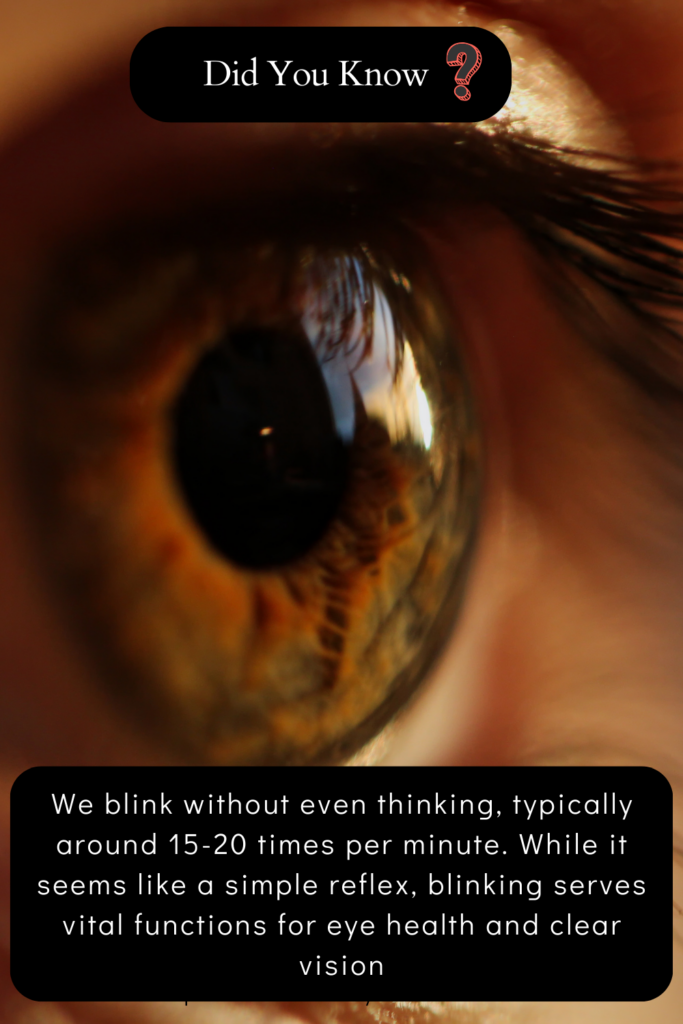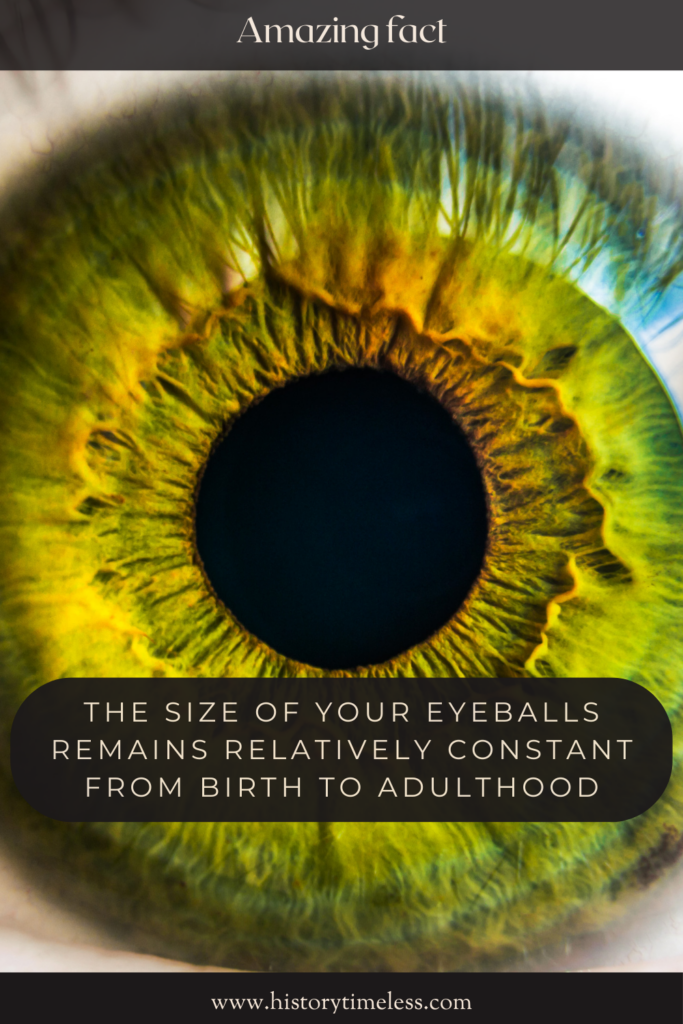Eyes are one of the most fascinating and complex organs in the human body. They allow us to see the world in vivid detail, process millions of colors, and even adjust to different lighting conditions in an instant.
But did you know that eyes can reveal a lot about your health, or that some animals have incredible vision far beyond human capabilities?
From the way our pupils react to emotions to the surprising fact that everyone has a blind spot, there’s so much to learn about these amazing organs. Here are some fascinating facts about eyes that might surprise you!
1. Your Eyes Can Differentiate Around 10 Million Colors, A Rainbow in Every Glance
The human eye is an incredible instrument of perception, capable of distinguishing an astonishing range of colors. Thanks to specialized cells called cone cells located in the retina, we can perceive hues spanning the visible spectrum and beyond.
These cones are sensitive to different wavelengths of light, roughly corresponding to red, green, and blue.
The brain then processes signals from these cones to create the rich tapestry of colors we experience in our daily lives, from the subtle shades of a sunset to the vibrant colors of a flower garden. This vast color palette adds immense depth and beauty to our visual world.
2. Blinking Is Not Just Reflex, It’s a Crucial Eye Cleaning and Lubrication System
We blink without even thinking, typically around 15-20 times per minute. While it seems like a simple reflex, blinking serves vital functions for eye health and clear vision.

Each blink spreads a thin layer of tears across the surface of the eye, keeping it moist and preventing dryness and irritation. This tear film is essential for lubricating the cornea and washing away dust and debris that can obstruct vision and cause discomfort.
Blinking also helps to reduce eye strain by briefly resting the eye muscles and allowing them to refocus, contributing to overall visual comfort and clarity.
3. Eyes are the Second Most Complex Organ, Only Behind the Brain in Intricacy
The human eye, despite its relatively small size, is a remarkably complex and intricately designed organ. It’s often cited as the second most complex organ in the body, after the brain itself, which is a testament to its sophisticated structure and function.
From the cornea that bends light entering the eye, to the lens that focuses it, the iris that controls light levels, and the retina that converts light into electrical signals, each part works in perfect harmony.
This complex system allows us to perceive the world in incredible detail, highlighting the eye’s remarkable biological engineering.
4. Your Cornea, the Eye’s Clear Window, Gets Oxygen Directly from the Air
Unlike most tissues in the body that rely on blood vessels for oxygen, the cornea, the transparent front part of your eye, gets its oxygen directly from the air.
This unique adaptation is essential for maintaining the cornea’s clarity, as blood vessels would obstruct light and impair vision. The cornea’s direct interaction with the atmosphere allows for efficient oxygen uptake, crucial for its cellular processes and overall health.
This direct oxygen supply is a fascinating example of how the eye is uniquely adapted to its function of allowing light to enter for vision.
5. Eye Muscles Are the Fastest Muscles in Your Body, Enabling Rapid Eye Movements
The muscles that control eye movement are incredibly fast and agile, making them the quickest muscles in the human body. These extraocular muscles allow our eyes to dart around rapidly, enabling us to quickly shift our gaze, track moving objects, and read lines of text smoothly.
This rapid movement is crucial for processing visual information efficiently and reacting quickly to changes in our surroundings.
The speed and precision of these muscles are essential for our dynamic visual perception and interaction with the world.
6. Each of Your Eyes Has a “Blind Spot” Where the Optic Nerve Connects
Intriguingly, each of our eyes has a blind spot, a small area on the retina where the optic nerve connects to the brain. At this point, there are no photoreceptor cells (rods and cones) to detect light.
However, we are typically unaware of this blind spot in our everyday vision because our brain cleverly fills in the missing information using the visual data from the surrounding areas and the other eye.
This natural “in-painting” process is a testament to the brain’s remarkable ability to create a seamless and complete visual experience even with minor gaps in sensory input.
7. Babies Are Born Colorblind, Developing Full Color Vision Over Time
When babies are born, their color vision is not fully developed. They primarily see in shades of gray. The cone cells in their retinas, responsible for color perception, are still maturing in the first few months of life.
Gradually, babies start to perceive colors, with red being among the first to be distinguished. Full color vision typically develops over several months, enriching their visual experience as they grow and explore their colorful world. This developmental process highlights the complex maturation required for complete visual function.
8. Tears Are Not Just for Crying; They Have Three Layers with Different Functions
Tears are more than just emotional responses; they are a complex fluid essential for eye health and comfort. Tears are composed of three distinct layers: the oily (lipid) layer, the watery (aqueous) layer, and the mucus (mucin) layer.
The oily layer, the outermost, prevents tear evaporation. The watery layer, the middle and thickest, hydrates and nourishes the eye.
The mucus layer, closest to the eye surface, helps tears spread evenly. These three layers work synergistically to keep the eye lubricated, protected, and functioning optimally.
9. Your Eyes Can Focus on Approximately 50 Things Per Second, A Visual Superpower
The human eye and brain work together at an incredible speed, allowing us to focus on roughly 50 different objects every second.
This rapid processing capability is essential for navigating our complex visual environment and quickly switching attention between different points of interest.
This ability to rapidly refocus and process visual information contributes to our seamless perception of the world and enables us to react swiftly to visual cues and changes in our surroundings.
10. Eye Color Is Determined by Melanin, Just Like Skin and Hair Pigment
The captivating variety of eye colors we see in people is determined by the amount and type of melanin, the same pigment that colors our skin and hair, present in the iris.
More melanin in the iris results in darker eye colors like brown and black, while less melanin leads to lighter colors such as blue and green. Genetics plays a significant role in determining melanin levels, leading to the diverse spectrum of eye colors across the global population.
Interestingly, blue eyes do not actually contain blue pigment; they appear blue due to the way light scatters in the iris.
11. Heterochromia, Different Colored Eyes, Is a Result of Uneven Melanin Distribution
Heterochromia, the condition of having different colored eyes or different colors within the same iris, is a fascinating and relatively rare phenomenon.
It arises from variations in the concentration and distribution of melanin within the irises. This uneven melanin distribution can be caused by genetic factors, genetic mutations, or certain medical conditions.
Heterochromia results in striking visual differences, making each eye uniquely colored and adding to the captivating diversity of human eye appearance.
12. Your Eyes Can “See” in 3D Thanks to Binocular Vision and Depth Perception
Humans possess binocular vision, meaning we have two eyes that work together to perceive the world. The slight difference in the images perceived by each eye is processed by the brain to create a sense of depth and three-dimensionality.
This depth perception, also known as stereopsis, is crucial for judging distances, navigating space, and interacting with our environment effectively.
Binocular vision allows us to appreciate the world in its full three-dimensional richness and is essential for many daily tasks and activities.
13. The Size of Your Eyes Stays the Same from Birth, Unlike Other Body Parts
Interestingly, the size of your eyeballs remains relatively constant from birth to adulthood. While other parts of our body grow significantly as we develop, the eyes reach their adult size quite early in life.

This early stabilization of eye size is important for maintaining consistent visual function throughout life. While the eyes themselves don’t grow much, other visual structures and the brain’s visual processing centers continue to develop and refine our visual abilities over time.
14. Eyes Can Reveal Health Issues, Acting as Windows to Your Overall Well-being
Eyes are often referred to as “windows to the soul,” and in a literal sense, they can also be windows to your overall health.
Eye examinations can reveal signs of various systemic health conditions, including diabetes, high blood pressure, and even certain types of cancer. Changes in the blood vessels of the retina, for instance, can indicate vascular problems elsewhere in the body.
Regular eye check-ups are therefore not just important for vision but also for monitoring and maintaining overall health.
15. Digital Eye Strain Is a Modern Problem Caused by Prolonged Screen Time
In today’s digital age, digital eye strain, also known as computer vision syndrome, is a common issue. Prolonged use of digital devices like computers, smartphones, and tablets can lead to symptoms such as eye fatigue, dry eyes, blurred vision, headaches, and neck pain.
This strain arises from reduced blinking rate, focusing fatigue, and exposure to blue light emitted from screens. Taking regular breaks, adjusting screen settings, and practicing good ergonomics can help mitigate digital eye strain and protect eye health.
16. Sunglasses Are Not Just a Fashion Accessory, They Are Essential Eye Protection
Sunglasses are much more than a fashion statement; they are crucial for protecting your eyes from harmful ultraviolet (UV) radiation from the sun.
Excessive UV exposure can contribute to various eye conditions, including cataracts, macular degeneration, and photokeratitis (sunburn of the cornea).
Wearing sunglasses that block 100% of UVA and UVB rays is essential for safeguarding eye health, especially during prolonged sun exposure. Choosing quality sunglasses is a proactive step in preserving long-term vision.
17. Night Vision Is Possible Thanks to Rod Cells, Sensitive to Low Light Conditions
Our ability to see in low light conditions, often referred to as night vision, is primarily due to specialized photoreceptor cells in the retina called rod cells.
Rod cells are highly sensitive to light and are responsible for our peripheral vision and vision in dim environments.
While rod cells do not detect color, they excel at detecting motion and shades of gray in low light, allowing us to navigate and perceive our surroundings even when light levels are minimal. This adaptation is crucial for vision in nighttime and dimly lit settings.
18. Contact Lenses Were Envisioned by Leonardo da Vinci Centuries Ago, Long Before Invention
The concept of contact lenses is surprisingly old, dating back to Leonardo da Vinci in the 16th century. Da Vinci sketched ideas for lenses that could be placed directly on the eye to correct vision.
However, it wasn’t until the late 19th century that practical contact lenses were developed. This historical perspective highlights the enduring human desire to improve vision and the long journey from conceptualization to the technological realization of contact lenses as we know them today.
19. People Actually Can Have Different Eye Colors, Even Within the Same Eye (Sectoral Heterochromia)
While heterochromia often refers to having different colored eyes, it can also manifest as sectoral heterochromia, where different colors are present within the same iris.
This variation within a single iris can create striking patterns, with segments of different colors coexisting in the same eye.
Sectoral heterochromia is another fascinating example of the diverse ways melanin distribution can influence eye color, leading to unique and captivating visual appearances.
20. Your Eyes Can Focus Automatically, A Process Called Accommodation
The human eye has an amazing ability to automatically adjust its focus between near and far objects, a process called accommodation.
This is achieved by the lens inside the eye changing shape, becoming thicker to focus on nearby objects and thinner for distant ones. This rapid and seamless adjustment allows us to maintain clear vision at varying distances without conscious effort.
Accommodation is a critical function for our visual adaptability and ability to navigate a world with objects at different distances.
21. Eyebrows and Eyelashes Have a Purpose Beyond Aesthetics, They Protect Your Eyes
Eyebrows and eyelashes are not just facial features; they serve important protective functions for the eyes. Eyebrows help to divert sweat and rain away from the eyes, preventing irritation and blurred vision.
Eyelashes act as a barrier, trapping dust, debris, and small particles, preventing them from entering the eye and causing damage or infection. These seemingly decorative features are actually crucial components of the eye’s defense system.
22. Dreams Occur Even for People Who Are Blind, Just Not Always Visually
People who are blind, even those blind from birth, still dream. However, their dreams may differ in sensory content compared to sighted individuals.
Dreams for blind individuals may be more focused on other senses like sound, touch, smell, and taste rather than visual imagery.
The content and nature of dreams are complex and influenced by individual experiences and sensory perception, highlighting the brain’s capacity for rich and varied dream experiences regardless of visual ability.
23. Tears of Joy and Sadness Have Different Chemical Compositions, Reflecting Emotions
Interestingly, tears shed due to different emotions, such as joy and sadness, can have slightly different chemical compositions.
Emotional tears, like those shed during sadness, contain higher levels of stress hormones, such as prolactin and adrenocorticotropic hormone (ACTH), compared to basal tears (tears that lubricate the eye) or reflex tears (tears in response to irritation).
This difference in composition suggests that emotional tears may play a role in releasing stress-related chemicals from the body.
24. Some People Are Born with Two Different Eye Colors (Complete Heterochromia)
Complete heterochromia iridum is the condition where an individual is born with two irises of completely different colors. This is the most striking form of heterochromia and is relatively rare in humans.
The difference in color is due to varying concentrations of melanin in each iris, resulting in one eye appearing, for example, brown while the other is blue or green. Complete heterochromia is a visually distinct and captivating genetic trait.
25. Humans Typically Only Use One-Sixth of Their Eyeball Above the Eyelid
It might seem surprising, but we typically only expose about one-sixth of our eyeball above the eyelid. The majority of the eyeball is protected within the bony socket of the skull.
This anatomical arrangement provides significant protection for the delicate eye structures from injury and external elements.
The exposed portion is sufficient for capturing the necessary visual information, while the enclosed part remains shielded and supported.
26. Fingerprints of the Eye: Your Iris Has a Unique Pattern, Like a Fingerprint
Just like fingerprints, the iris of your eye has a unique and complex pattern of ridges, furrows, and spots. This iris pattern is so distinctive that it can be used for biometric identification, similar to fingerprints.
Iris recognition technology utilizes these unique patterns to identify individuals with high accuracy. This incredible level of individuality makes the iris a powerful and secure biometric identifier, showcasing yet another fascinating aspect of eye complexity.
Get lost in these intriguing nuggets:
28 Fascinating Facts About Earth You Probably Didn’t Know!
25 Funny Weird Facts That Will Make You Go “Wait, What?!”
20+ Insane Facts About Animals That Defy Belief!
15+ Interesting World Facts: Say ‘Wow’ to These Discoveries!





